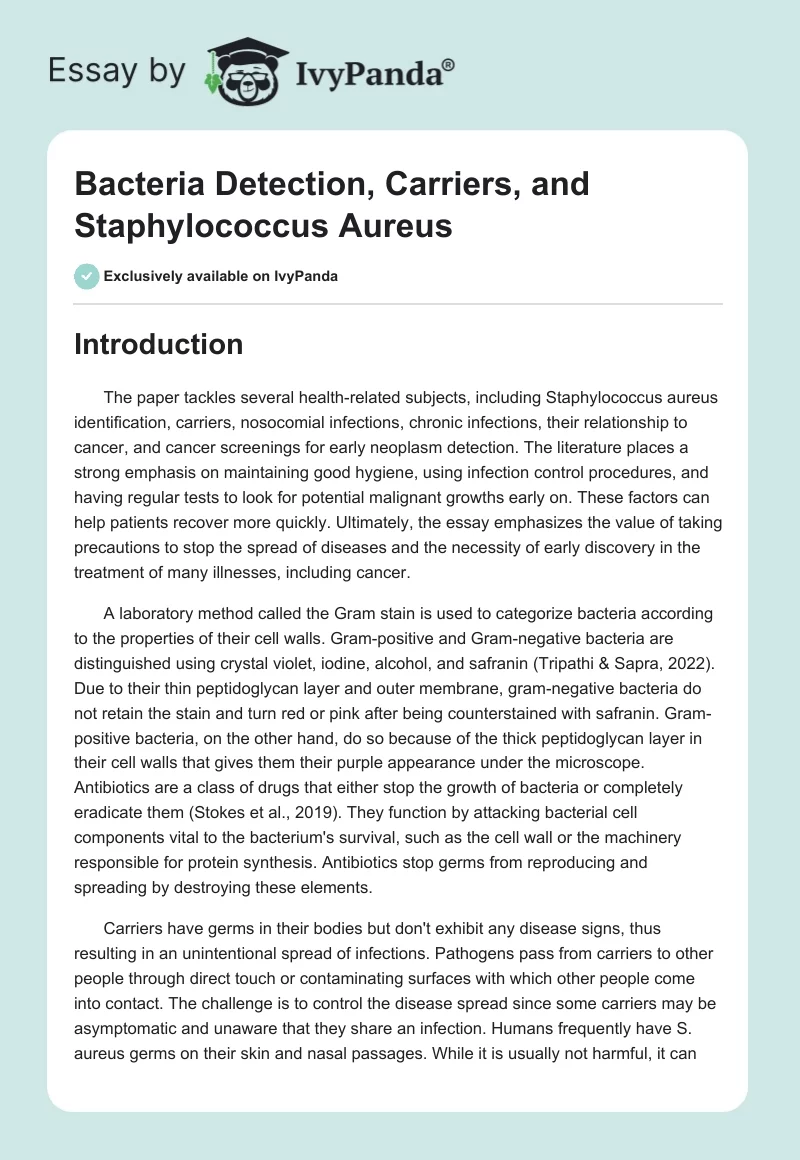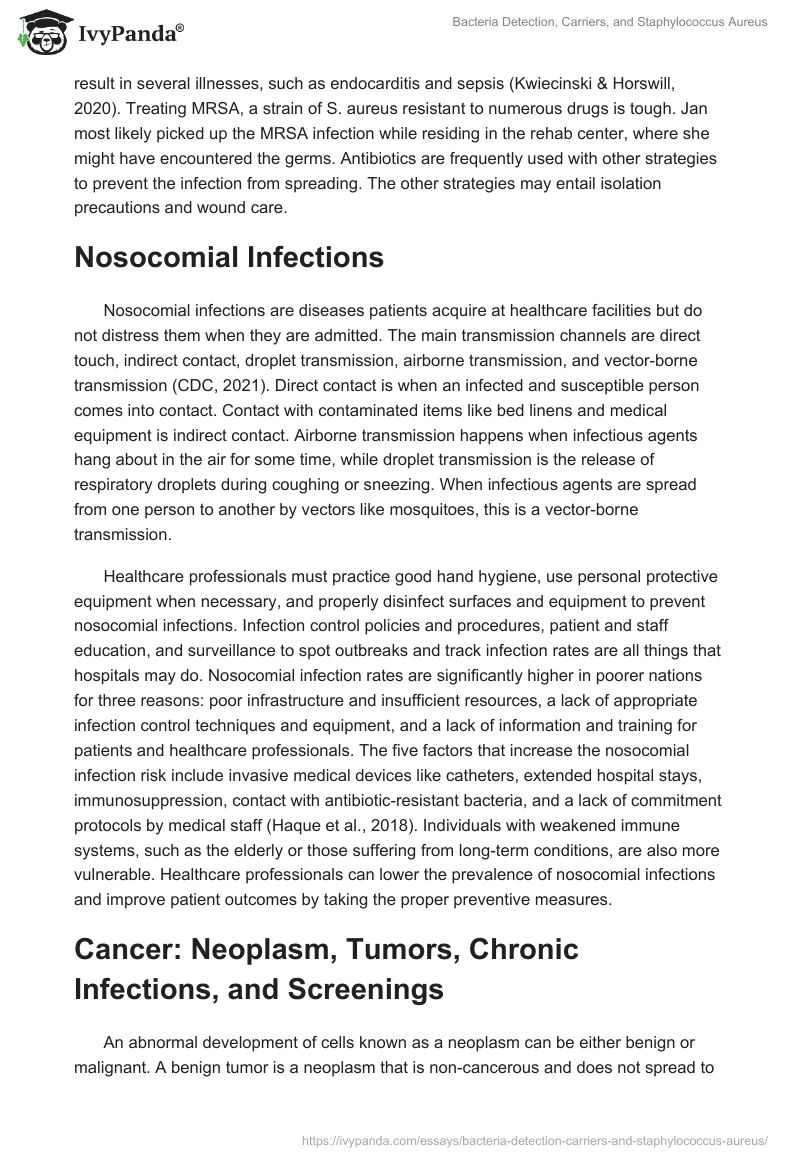Introduction
The paper tackles several health-related subjects, including Staphylococcus aureus identification, carriers, nosocomial infections, chronic infections, their relationship to cancer, and cancer screenings for early neoplasm detection. The literature places a strong emphasis on maintaining good hygiene, using infection control procedures, and having regular tests to look for potential malignant growths early on. These factors can help patients recover more quickly. Ultimately, the essay emphasizes the value of taking precautions to stop the spread of diseases and the necessity of early discovery in the treatment of many illnesses, including cancer.
A laboratory method called the Gram stain is used to categorize bacteria according to the properties of their cell walls. Gram-positive and Gram-negative bacteria are distinguished using crystal violet, iodine, alcohol, and safranin (Tripathi & Sapra, 2022). Due to their thin peptidoglycan layer and outer membrane, gram-negative bacteria do not retain the stain and turn red or pink after being counterstained with safranin. Gram-positive bacteria, on the other hand, do so because of the thick peptidoglycan layer in their cell walls that gives them their purple appearance under the microscope. Antibiotics are a class of drugs that either stop the growth of bacteria or completely eradicate them (Stokes et al., 2019). They function by attacking bacterial cell components vital to the bacterium’s survival, such as the cell wall or the machinery responsible for protein synthesis. Antibiotics stop germs from reproducing and spreading by destroying these elements.
Carriers have germs in their bodies but don’t exhibit any disease signs, thus resulting in an unintentional spread of infections. Pathogens pass from carriers to other people through direct touch or contaminating surfaces with which other people come into contact. The challenge is to control the disease spread since some carriers may be asymptomatic and unaware that they share an infection. Humans frequently have S. aureus germs on their skin and nasal passages. While it is usually not harmful, it can result in several illnesses, such as endocarditis and sepsis (Kwiecinski & Horswill, 2020). Treating MRSA, a strain of S. aureus resistant to numerous drugs is tough. Jan most likely picked up the MRSA infection while residing in the rehab center, where she might have encountered the germs. Antibiotics are frequently used with other strategies to prevent the infection from spreading. The other strategies may entail isolation precautions and wound care.
Nosocomial Infections
Nosocomial infections are diseases patients acquire at healthcare facilities but do not distress them when they are admitted. The main transmission channels are direct touch, indirect contact, droplet transmission, airborne transmission, and vector-borne transmission (CDC, 2021). Direct contact is when an infected and susceptible person comes into contact. Contact with contaminated items like bed linens and medical equipment is indirect contact. Airborne transmission happens when infectious agents hang about in the air for some time, while droplet transmission is the release of respiratory droplets during coughing or sneezing. When infectious agents are spread from one person to another by vectors like mosquitoes, this is a vector-borne transmission.
Healthcare professionals must practice good hand hygiene, use personal protective equipment when necessary, and properly disinfect surfaces and equipment to prevent nosocomial infections. Infection control policies and procedures, patient and staff education, and surveillance to spot outbreaks and track infection rates are all things that hospitals may do. Nosocomial infection rates are significantly higher in poorer nations for three reasons: poor infrastructure and insufficient resources, a lack of appropriate infection control techniques and equipment, and a lack of information and training for patients and healthcare professionals. The five factors that increase the nosocomial infection risk include invasive medical devices like catheters, extended hospital stays, immunosuppression, contact with antibiotic-resistant bacteria, and a lack of commitment protocols by medical staff (Haque et al., 2018). Individuals with weakened immune systems, such as the elderly or those suffering from long-term conditions, are also more vulnerable. Healthcare professionals can lower the prevalence of nosocomial infections and improve patient outcomes by taking the proper preventive measures.
Cancer: Neoplasm, Tumors, Chronic Infections, and Screenings
An abnormal development of cells known as a neoplasm can be either benign or malignant. A benign tumor is a neoplasm that is non-cancerous and does not spread to other areas of the body, but a malignant tumor is a neoplasm that invades tissues and spreads through the bloodstream or lymphatic system (Patel, 2020). By cell damage and the promotion of genetic abnormalities that may result in aberrant cell growth, persistent infections have been linked to cancer. Human papillomavirus (HPV), hepatitis B and C viruses, HIV, and Epstein-Barr virus (EBV) are four chronic illnesses that can result in cancer. Cervical, anal, and head and neck cancers are significantly more likely to develop with HPV infection. Liver cancer can result from hepatitis B and C viruses (Maucort-Boulch et al., 2018). A kind of skin cancer called Kaposi’s sarcoma, and lymphomas are more likely to occur in people with HIV infection. Nasopharyngeal cancer and Hodgkin’s lymphoma are both linked to EBV infection.
Mr. and Mrs. Brown should get screenings to identify potential malignant growths early. Prostate, colon, and lung cancer screening are commonly recommended for men, while breast, cervical, and colon cancer screening are advisable for women. Prostate-specific antigen testing and a digital rectal exam help in prostate cancer screening. For colon cancer screening, fecal occult blood tests and colonoscopies are useful (Ahlquist, 2019). For those with a history of heavy smoking, a low-dose computed tomography (CT) scan is helpful for lung cancer screening. Mammography applies to breast cancer screening, while an HPV test or Pap smear works for cervical cancer screening. These tests aid in the early detection of cancer when it is most curable.
Colorectal Cancer, Cervical Cancer, Warning Signs, and A Possible Diagnosis
Due to many reasons, colorectal cancer is the most prevalent cancer in Western nations. A few variables contributing to the rising prevalence of colorectal cancer include sedentary lifestyles, aging populations, and increased consumption of processed and red meat. There has been a decrease in the incidence and death of cervical cancer given the increased cervical cancer screening and immunization programs for the HPV, a significant risk factor for the disease. Cervical cancer can be avoided with regular Pap tests and HPV vaccines while lowering death rates relies on early detection and treatment (Drokow et al., 2021). Nonspecific cancer warning symptoms can be difficult to identify because some illnesses might bring them on. Unexpected weight loss may indicate the presence of several malignancies, including colon, lung, and pancreatic cancer. Leukemia, lymphoma, and colon cancer, among others, can all show signs of fatigue. In persistent discomfort, ovarian, testicular, and bone cancers are palpable, while skin changes may indicate skin malignancies. Nevertheless, these vague symptoms might be brought on by a wide range of illnesses, making it imperative to seek medical advice for an accurate diagnosis.
Aaron may have Hodgkin’s lymphoma, cancer associated with EBV infection, given the symptoms of a large lymph node in his neck and night sweats. Chemotherapy, radiation therapy, and stem cell transplantation are among the treatment options for Hodgkin’s lymphoma (American Cancer Society, 2018). The particular course of treatment will depend on several variables, including the patient’s general health and cancer stage. The main treatment for Hodgkin’s lymphoma is chemotherapy, where radiation therapy in high-energy medications destroys cancer cells and shrinks tumors. Patients for whom chemotherapy does not suffice may benefit from stem cell transplantation as a treatment option. It entails adding healthy stem cells to the patient’s damaged bone marrow.
Conclusion
The different themes linked to human health and sickness have been covered in this essay. It has examined the usage of antibiotics to stop bacterial illnesses as well as the taxonomy of bacteria using the Gram stain method. It has also been discussed the idea of carriers and nosocomial infections, emphasizes the significance of good hygiene standards in healthcare institutions to stop the transmission of diseases. The study also covered several cancers, their causes, and the value of screening for early detection. Prioritizing preventative measures is essential if you want to stay healthy and stop diseases from developing or getting worse. People can lower their chance of contracting diseases and enhance their overall quality of life by staying informed and implementing the proper preventive steps. To guarantee the greatest results for their patients, healthcare professionals must also be diligent and up-to-date on the latest methods for illness prevention and treatment.
References
Ahlquist, D. A. (2019). Stool-Based Tests vs Screening Colonoscopy for The Detection of Colorectal Cancer. Gastroenterology & hepatology, 15(8), 437-440. Web.
American Cancer Society. (2018). Hodgkin lymphoma stem cell transplant & high dose chemo. Web.
CDC. (2021). Principles of Epidemiology | Lesson 1 – Section 10. Centers for Disease Control and Prevention. Web.
Drokow, E. K., Effah, C. Y., Agboyibor, C., Sasu, E., Amponsem-Boateng, C., Akpabla, G. S., Ahmed, H. A., & Sun, K. (2021). The Impact of Video-Based Educational Interventions on Cervical Cancer, Pap Smear and HPV Vaccines. Frontiers in Public Health, 9. Web.
Haque, M., Sartelli, M., McKimm, J., & Abu Bakar, M. B. (2018). Health Care-Associated Infections – An Overview. Infection and Drug Resistance, 11, 2321-2333. Web.
Kwiecinski, J. M., & Horswill, A. R. (2020). Staphylococcus aureus Bloodstream Infections: Pathogenesis and Regulatory Mechanisms. Current Opinion in Microbiology, 53, 51-60. Web.
Maucort-Boulch, D., De Martel, C., Franceschi, S., & Plummer, M. (2018). Fraction and Incidence of Liver Cancer Attributable to Hepatitis B and C Viruses worldwide. International Journal of Cancer, 142(12), 2471-2477. Web.
Patel, A. (2020). Benign vs Malignant Tumors. JAMA Oncology, 6(9), 1488. Web.
Stokes, J. M., Lopatkin, A. J., Lobritz, M. A., & Collins, J. J. (2019). Bacterial Metabolism and Antibiotic Efficacy. Cell Metabolism, 30(2), 251-259. Web.
Tripathi, N., & Sapra, A. (2022). Gram Staining. National Center for Biotechnology Information. Web.


